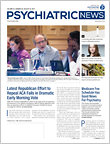“The current generation of learners relates to the internet more as an extension of themselves than as an external resource.” —2012 AADPRT Task Force Report on Professionalism and the Internet in Psychiatry: What to Teach and How to Teach It
The digital revolution and social media are having a profound effect on medicine and patient care, and as the statement from the AADPRT task force report suggests, young physicians in training are likely to approach the use of these tools much differently from more senior doctors.
“When we talk to trainees about digital technology, it’s very clear that many of them view their online and social media presence on LinkedIn, for instance, as an extension of their identity, not just as a vehicle for communication,” said Sandra DeJong, M.D., president of the American Association of Directors of Psychiatric Residency Training (AADPRT). “People are curating their identities on social media sites, but for physicians, that can mean some interesting things in terms of challenging conventional boundaries around professional identity versus private identity, as well as challenging the traditional framework for professional space and time.
“We used to set up appointments for 45 minutes, but now there is the expectation that you are available almost 24/7,” DeJong said. “This disruption of the conventional treatment frame has an impact on the psychiatrist-patient relationship and raises all kinds of new questions.”
For example, DeJong asks, “Is it OK for a physician to follow his or her patient on Twitter?”
(During a symposium at this year’s Annual Meeting in San Diego titled “Patient Targeted Googling: Oh! What a Tangled Web We Weave, When First We Practice to Deceive,” psychiatrist Lilya Gershengoren, M.D., presented results from a pilot survey showing that more than 80 percent of resident trainees at a large academic medical center had Googled the name of a patient, and nearly all of them had at least considered doing so. (
Psychiatric News, July 7).
“All of these traditional parameters are being challenged by digital technology,” DeJong said. “This has required medical educators to think about how we talk to trainees and fellows about the wise, responsible, and ethical use of digital tools.”
Moreover, technology is constantly evolving. LinkedIn and Facebook became popular more than a decade ago, but it is only very recently that mental health apps, some of which can track patient symptoms in real time, have begun to be marketed.
For that reason, AADPRT is updating its Curriculum on Professionalism and the Internet, first developed in 2010 by a task force under then-AADPRT President Sheldon Benjamin, M.D., and released in 2012. The original curriculum was also accompanied by a task force report, published in Academic Psychiatry in September 2012.
“We made a commitment when we issued the curriculum to keep it current as needed,” DeJong said. “This subject of digital technology is a moving target, so this really needs to be a dynamic document. We are in the process of updating the teaching vignettes to include some about the use of apps.”
The original 2010 curriculum is comprehensive, including 36 vignettes describing situations in which digital technology or social media impact the clinical setting. An example of one of the more basic teaching vignettes for discussion is the following:
A psychiatrist has just had her third visit with a patient. About this time the psychiatrist is “friended” on Facebook by an old high school classmate. However, the communications from the “classmate” do not appear to be genuine; in fact, this person appears to be an imposter. The psychiatrist is able to ascertain from the person’s Facebook page that the friend is actually the new patient who had located the psychiatrist’s high school year book online.
Many other vignettes describe more complex situations involving nuanced decision making around patient care and professional ethics and include annotated references to guide learners. All of the vignettes are grounded in the real experiences of psychiatrists working with patients.
“Even before the task force was created, we held a workshop at an AADPRT annual meeting where it became clear there was a huge need for education in this area,” DeJong said. “At that workshop and subsequent ones, we collected material in the form of stories people submitted to us and developed these teaching vignettes based on actual clinical experience.”
It is not known how widely the AADPRT curriculum is being employed at institutions around the country, but DeJong said that anecdotally the level of consciousness among educators about issues relating to digital technology and medical professionalism has dramatically increased. “Many of the changes that are happening in medical education are happening at the institutional level rather than the training-program level.”
She continued, “I think technology is going to become an increasingly important part of all health care, and that will be true for mental health care as well. Somehow we have to find a balance between making sure our graduates have the necessary skills to function and use these new tools skillfully, while also helping them develop the thought process that allows them to pause, think about the ramifications of these tools, and remember the important tenets of psychiatric professionalism.
“Moreover, I think psychiatry is different in that our patients are vulnerable in a variety of ways, and the kind of information we are privy to is especially intimate. I think that places on psychiatrists a higher obligation to pay attention to the core ethical values of our profession.” ■
APA offers a course based on the AADPRT curriculum titled “Professionalism and the Internet.” It can be accessed
here. An abstract of “Professionalism and the Internet in Psychiatry: What to Teach and How to Teach It” is available
here.

